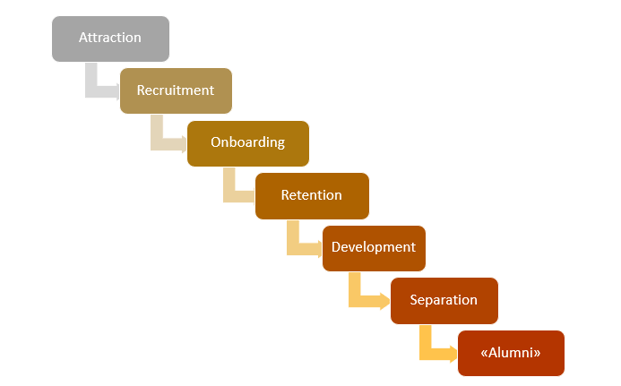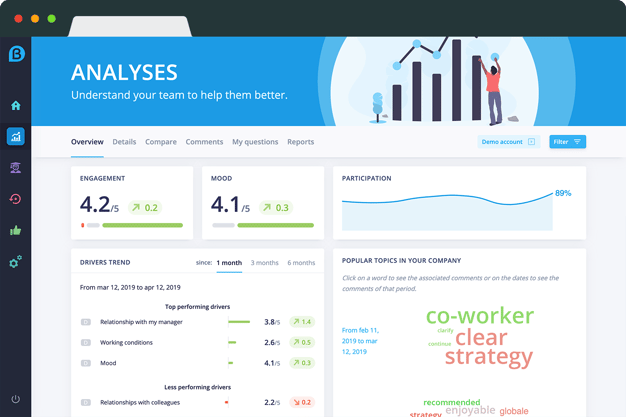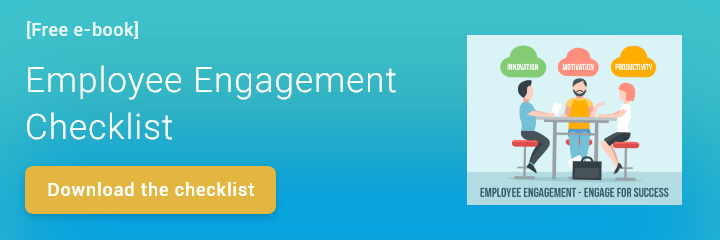Whether it’s feedback from employees, between colleagues or about the employee experience or satisfaction offered by a company, finding smart ways to gather internal feedback is a key strategic priority for HR teams. In this article, we explain how you can incorporate surveys into your HR strategy.
In the past, HR teams had 2 main ways of gathering feedback:
- annual reviews, assuming these were conducted properly, with appropriate measures in place to ensure such feedback was confidential and constructive (that’s 95% of reviews out the window!);
- annual surveys that gauged mood within an organisation, for companies that used them.
Nowadays, there is a real need to give and receive regular, frequent feedback, and technology is making it possible to do more with feedback, do it better and make it more useful for everyone. The options available to us are growing fast and nothing seems impossible when it comes to people development.
The 7 stages of the “employee life cycle”
Are you trying to establish a feedback culture in your company? Where should you begin? It all depends on your priorities. Do you want to reduce staff turnover? Develop your employees? Onboard new recruits more quickly? Bring managers in line with one another? From their very first interview to the day they leave your company, an employee’s experience will vary. Once you understand this, you can improve each of the stages of the employee life cycle and, in doing so, make a positive impact on their quality of work life and efficiency. Each stage of the cycle has its own specific feedback requirements.
The 7 stages of the employee life cycle:
- Attraction: how a company’s employer brand is perceived is crucial when it comes to attracting new talent.
- Recruitment: an employee and a company together embark on a complex journey that can either scare them off or draw them in.
- Onboarding: this initial period is a determining factor in what follows.
- Retention: how can resignations be avoided?
- Development: how can employees be supported to develop and acquire new technical and behavioural skills?
- Separation: what can we do to understand why people leave and prevent further resignations?
- “Alumni”: former employees have a direct impact on your employer brand.

In addition to these stages, there is a whole host of different types of feedback, each with its own distinctive features. By carefully selecting from among these, you can develop a tailored solution that meets your specific needs. It is also vital that your chosen technology is flexible and allows you to respond to most of your needs, otherwise you will end up having to use a number of different feedback platforms. It must be able to handle a range of options, from pulse surveys to company surveys, bespoke questionnaires, 360° or 180° feedback surveys and feedback requests.
- Individual vs. collective employee feedback
- Recurrent vs. one-off employee surveys
- Targeted vs. “universal” employee feedback
- Feedback used to assess or develop employees
- Quantitative vs. qualitative employee feedback
 An example of a Bleexo employee satisfaction survey result
An example of a Bleexo employee satisfaction survey result
Employee feedback: reservations and managerial maturity
- Pragmatics of Human Communication
In Pragmatics of Human Communication, Watzlawick, Jackson and Helmick Beavin highlight the systemic nature of communication. As soon as we see a request for feedback as an interaction and the response (or lack thereof) as a reaction, it becomes clear that what we are engaging in is a systemic conversation. This is the angle from which feedback culture should be understood.
When you ask for feedback, you are communicating, but be aware that if you do not ask for feedback, you are still communicating. As Watzlawick, Jackson and Helmick Beavin put it: “one cannot not communicate.”
- Pandora’s box
Some of your colleagues (perhaps even you yourself?) will have reservations about giving and receiving feedback. Whether it’s introducing an employee survey, requesting 360° feedback, running a poll or asking people about their employee experience, they will worry that they are about to open Pandora’s box. It’s more comfortable not to know, or have others believe you don’t know, or to be in denial. Comfort aside, and to return to this notion of the “company as a systemic organisation”, an “infection” will only spread and lead to bigger problems, such as stress, resignations, staff feeling unhappy at work reduced quality reduced efficiency. And so the vicious circle begins...
By establishing a feedback culture, you are making the right decision. Unpleasant though it may be, it’s best to identify and understand the problem. In any case, it will still be there, whether you have a feedback system in place or not. The problem isn’t created by feedback; rather, feedback reveals the problem. And the reverse is also true. By identifying existing strengths, best practice and positive energy, you can enhance and build on them.

- Managerial maturity
Companies do not all have the same managerial maturity. Even managers within the same company may not have the same maturity. We’re not talking about how many years of management experience they have under their belt, but rather the maturity of the management being practised. As it turns out, buy-in to a feedback culture is proportional to a company’s managerial maturity. It is therefore up to you to tailor your feedback strategy to your target populations (e.g. in terms of the type of feedback being gathered, how it will be used and shared and what implications this may have).
Support: the key to successfully incorporating employee feedback into your HR strategy
As the project manager tasked with establishing a feedback culture, you should focus your efforts on ensuring those affected have adequate support. There are normally 3 groups that have to be monitored.
- Supporting senior managers
As with all big projects, senior managers have a key role to play as “sponsors” of your efforts to establish a feedback culture. Their involvement and engagement are therefore vital. Their main job is to communicate:
- Reiterating why the approach is being adopted.
- Giving regular updates on concrete ways in which feedback is being used.
- Supporting managers
Managers are on the front line and as such play a key role in implementing your strategy. It is here that you will find opinion most divided. Some will have serious reservations and try to hold back the project, while others will be fast adopters and may want to do too much too soon, before their teams are ready. Your role is therefore to focus on education. How should they talk about the tool with their team? How should it be deployed? What should be expected from it? What should be done with it? How can disappointments be avoided? You should show that you are ready to listen and that your door is always open during this early phase so that you understand and can iron out any snags – the little things that can bring your project to a halt and even wreck it completely.
- Supporting employees
The third and final group is employees. Giving feedback takes time, requires honesty and a degree of courage and creates expectations. It is vital that the person asking for feedback in turn feeds back on how responses have been used, the conclusions that were reached and any changes that have been made as a result of respondents’ feedback. If feedback is requested regularly, so responses to this feedback must also be provided regularly. If feedback is provided on a one-off basis (as, for example, in the case of a 360° feedback survey), then getting back to each respondent is really important.
In the loop: feeding back on feedback
Skip this vital part of the “feedback loop” and the punishment will be swift and irreversible: no one will respond to your surveys. You may want to blame your surveying tool, when it’s really your own practice you should be addressing. “Have we clearly demonstrated to respondents the importance of their responses and how we have used them?”. As we learned earlier, we cannot not communicate. Without this feedback loop, your employees will be left with the impression that you don’t give a damn about their responses.
To avoid this, make sure you regularly ask for feedback on feedback.




